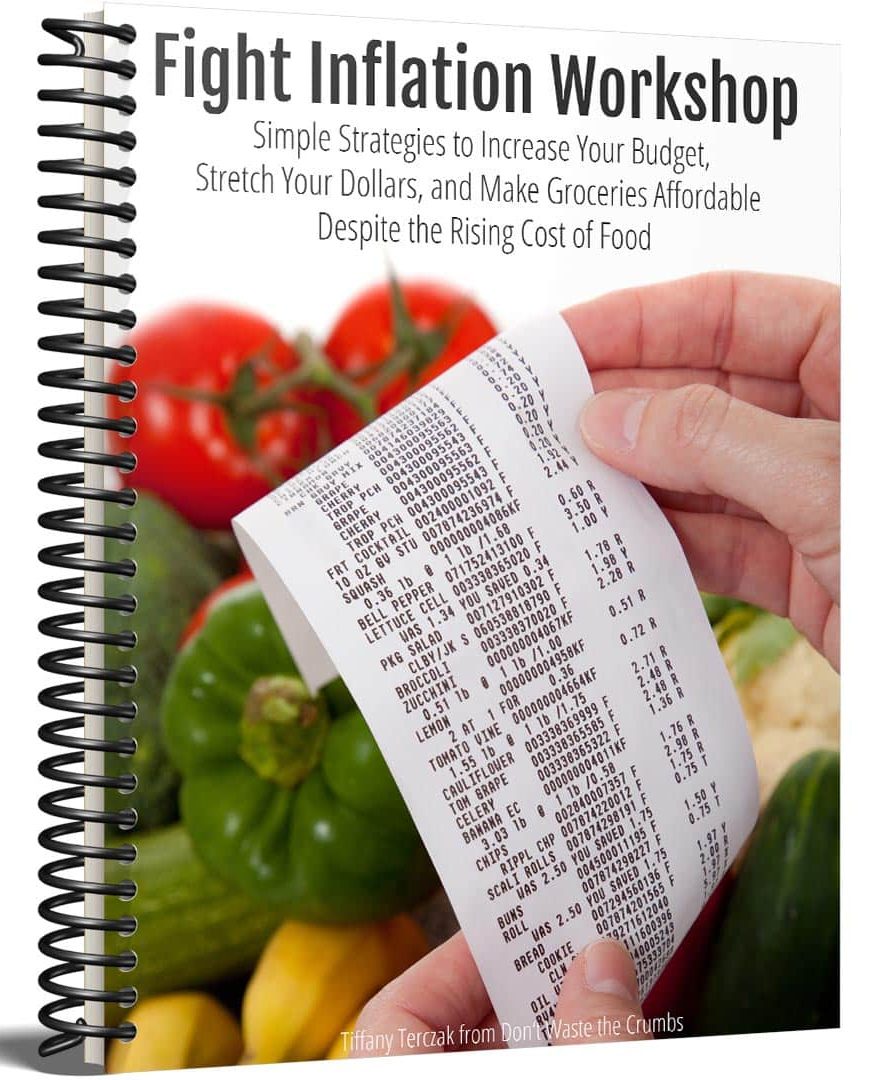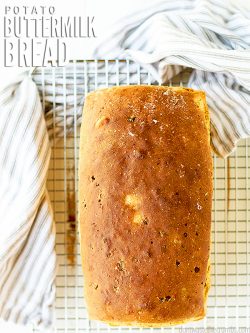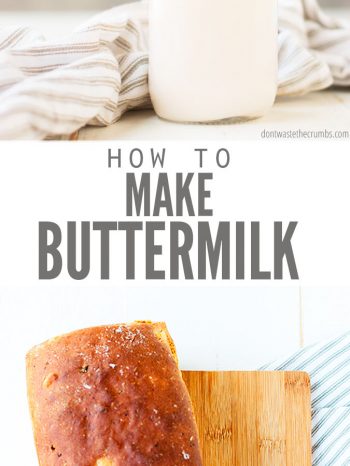If you’ve ever wondered how to make buttermilk, here’s your guide! From authentic homemade versions to quick and easy buttermilk substitutes, add fluff and tang to your favorite recipes.

When I think of “buttermilk,” I think of big, fluffy, buttery biscuits next to a big plate of fried chicken.
What comes to mind for you? Pancakes? Ranch Dressing? Moist quick breads? Maybe a piping hot loaf of Potato Buttermilk Bread? Yum!
There’s something about the word buttermilk that makes us think “big and fluffy” and “rich and flavorful,” but here’s something you might not know:
WHAT IS BUTTERMILK?
Buttermilk is the liquid by-product that you get when you make butter. If you let the raw milk sit to sour before you make butter, your buttermilk will be naturally soured and slightly cultured. This slightly cultured beverage contains healthy bacteria that help keep our digestive system in proper working order (and should be refrigerated once it’s soured, by the way).
But it’s way more than just a substitute for milk in biscuits. It’s like the Swiss army knife of dairy liquids!

Here is why I LOVE buttermilk:
- Great flavor
- Multiple ways to make it
- Easier to digest
- So many great substitute methods exist

HOW TO MAKE BUTTERMILK (4 WAYS!)
You might be wondering how to make buttermilk, and I’ve got good news. It’s really easy, and there are multiple ways to do it!
- Make cultured butter. The liquid byproduct is cultured buttermilk.
- Buy a starter culture and combine it with fresh milk.
- Allow raw milk to sit at room temperature to clabber. Culture and re-culture several batches of milk until the milk thickens dependably and tastes tart, but not bitter.
- Combine 1 Tbsp of store-bought buttermilk per 1 cup of fresh milk and allow to thicken at room temperature, for 12 to 24 hours. As it sits out, it will get thicker and tangier.
If you have an affordable source of raw milk, either #1 or #3 will be your most frugal options. For those who do not, the best route will be #4, saving some from each batch to re-culture another one.

HOMEMADE BUTTERMILK SUBSTITUTES
- In a glass measuring cup add 1 Tablespoon distilled vinegar or apple cider vinegar to 1 cup of milk. Let the mixture sit at room temperature until the milk thickens, about 5-10 minutes.
- Combine 1 Tbsp of lemon juice and 1 cup of milk. Stir and allow to sit at room temperature until the milk thickens, for about 5-10 minutes.
- Add 1 ¾ tsp cream of tartar to 1 cup of milk. Allow to sit at room temperature until the milk thickens.
- Combine ¾ cup Plain Yogurt with ¼ cup whole milk.
- Mix ½ cup plain Homemade Greek Yogurt with ½ cup whole milk.
- Combine ½ cup sour cream with ½ cup whole milk.
- Substitute Homemade Kefir for buttermilk in a one-to-one ratio (thinning with whole milk as necessary).
How to make buttermilk affordable will depend on what you normally keep in your pantry!

6 REASONS TO MAKE HOMEMADE BUTTERMILK
Just in case “because it makes everything taste better” isn’t a good enough reason for you, here are six more reasons to consider using buttermilk more often and keep some in the fridge:
- It should be easier to digest for anyone who is lactose intolerant – much of the milk sugar has been broken down into lactic acid.
- The natural acidity inhibits the growth of bad bacteria, meaning it has a longer shelf life!
- You can make sour cream easily: 1 Tbsp buttermilk + 1 pint cream = homemade sour cream
- Let it sit at room temperature for 1-2 days until the milk has visibly separated from the whey. Strain the whey from the curds using a fine mesh strainer and you have homemade cream cheese.
- If you’re out of baking powder, substitute baking soda and replace the liquids in the recipe with buttermilk. Baking soda needs acid to activate it as a leavening agent, and buttermilk provides that acid.
- Use buttermilk in place of whey, yogurt, kefir, apple cider vinegar, or lemon juice when soaking grains to reduce phytic acid.

HOW TO MAKE BUTTERMILK FAQS
How to make buttermilk from regular milk?
If you have access to raw milk, you can use a starter culture and combine it with real milk. If you don’t have access to raw milk, you can combine 1 Tbsp of store-bought buttermilk per 1 cup of fresh milk and allow it to thicken at room temperature.
What can I use if I don’t have buttermilk?
There are multiple ways to make substitutes that are listed above. A substitute can be made using vinegar, lemon juice, cream of tartar, yogurt, sour cream, or kefir in combination with milk.
How much vinegar do I add to milk to make buttermilk?
To make a DIY buttermilk substitute using vinegar, follow a 1 Tbsp vinegar to 1 cup milk ratio. You can use white vinegar or apple cider vinegar.
Why use buttermilk instead of milk?
Buttermilk adds a tangy flavor to most recipes, as well as helping your baked goods be fluffy and moist. Plus, it contains healthy bacteria and can be easier to digest. And it’s so easy to make!
Can I make dairy-free buttermilk?
Yes! You can add 1 Tbsp. vinegar or lemon juice to 1 cup of coconut milk or almond milk for a dairy-free buttermilk substitute.
Can you freeze buttermilk?
Yes, you can freeze buttermilk for up to 3 months. Be sure to freeze in the portions you would use for recipes for easier thawing, like ice cubes. I like these silicon molds or an ice cube tray to freeze small amounts.

BUTTERMILK RECIPES
Looking for how to make buttermilk recipes now that you’ve made your own? Check out these!
- Potato Buttermilk Bread
- 21 Easy Chicken Marinade Recipes
- Pancakes
- Almond Crusted Baked Chicken (sub in buttermilk for milk)
- Homemade Ranch Dressing









Hi Sharon, I’m a bit confused on how to make buttermilk from raw milk? I do make my own raw butter from raw cream but only in small amounts so never enough for a recipe. I have added 2 tablespoons of apple cider vinegar to 2 cups of raw milk that has soured a little. Will this work to make 2 cups of buttermilk?
If I make buttermilk using powdered kiefer grains would it be considered cultured? Can I use it in cheeesemaking? Thanks Eileen
Hi Eileen,
I am sorry but we have not used powdered kefir grains, or the buttermilk for cheesemaking but maybe that’s something to look into for future. I’m sorry I couldn’t help. Thanks for sharing with us. 🙂
I use buttermilk as the “starter culture” for my cheese making… I use 6L of milk and when it’s heated and cooled to the correct temperature, I add about 1.5c of buttermilk and let it sit for 30 minutes before continuing with adding the rennet… not sure if this was the answer you were looking for…
I have access to low pasturized milk that still has cream and will have about a 2inch cream line that I will not go back to store bought. Can I still do the same process as the raw milk? If so, about how long will it have to set out? I keep my apartment between 61 – 68 normally.
Victoria, the cream of milk and low pasteurized milk can be used for a ton of things! It can be used for this recipe just don’t let it go sour. The time changes based on many variables but it should taste tart but not bitter and be creamier rather then milky.
If you skim the cream off the milk into a mason jar, add salt, and shake for a good long while you get the best butter! It makes a wonderful coffee creamer substitute as well.
Julie do you think I could use it as a starter? I would be adding it to the buttermilk that is left over from making butter?
This is an old post, but I wanted to share that Saco Buttermilk Powder is just about the most wonderful product I’ve ever met. I don’t have any connection to the company, but always like to let people know about it when talking buttermilk. Saco is real buttermilk made into a powder ; 4 tbsp of the powder + 1 cup of water is equal to 1 cup of buttermilk. You add the powder to the dry ingredients in your recipe and then just use a cup of water for the liquid part.
It tastes great and does a fantastic job tenderizing baked goods (because it’s actually the real buttermilk from making butter). In my opinion it does a much better job of making it easy and cheap to use buttermilk without the hassle of making a non-cultured buttermilk substitute or buying cultured buttermilk in the store, which usually doesn’t have any actual buttermilk in it. The fake buttermilk doesn’t work on baked goods the same way (it might add some flavor, but it doesn’t add tenderness), and often goes to waste because usually you don’t need a whole quart. Seriously, the texture of baked goods is completely different when you use real buttermilk–most people don’t know this because they get what’s in the store and don’t notice that there’s no buttermilk in it.
A 16 oz. container of Seco Powdered Buttermilk usually costs about $7.00 and is the equivalent of 20 cups of buttermilk (160 ounces). $0.04/ounce of buttermilk or $0.35/cup. A quart of fake liquid cultured buttermilk costs around $2.00 or up to $4.00 or more depending on the brand, or $0.50-$1.00/cup, or even more if you end up tossing unused portions. You can store Saco in the refrigerator and it will last more than a year, unless you find out how easy it is to use and start making buttermilk everything!
Thank you for sharing Julie! I especially appreciate the cost breakdown. 🙂
I have always used lemon juice in whole milk to make my buttermilk. I received kefir grains in the mail yesterday that I’m excited to start using.
I don’t have access to raw milk. Can I use pasteurized milk to mix with some store bought buttermilk. Do I understand that I can use the new buttermilk to remake more for about 3 times then I have to start over again?
I love the buttermilk starter I got from culturesforhealth.com. One packet of heirloom starter just keeps going and going. Mix it with milk, let it sit on the counter for a few hours (though the very first batch can take longer) when it sets, (it will resemble pudding) put it in the fridge for a few hours to cool it down and you have homemade cultured buttermilk. To make the next batch simply take a tablespoon from the original batch and mix it in another jar of milk and let it sit on the counter and on and on it goes. I make a fresh batch about every week and I use it to make my own sour cream. I haven’t bought buttermilk, sour cream or a starter in years. I do have to try the cream cheese trick tho. That will be a great way to use up the leftover buttermilk.
Thanks for sharing this H Lind; I’ve been wondering how their buttermilk culture worked. I wasn’t sure if it was a one-time, handful of time, etc. or if you could reuse it indefinitely. It sounds like it works much like kefir grains, except the existing buttermilk is the culture rather than the grains. Thanks again for sharing!! I bet it’s delicious!
Ooh I’ll have to get some buttermilk tomorrow so I can start making my own! I LOVE buttermilk pie – yum, yum, YUM!! My husband is allergic to milk, so I’m going to try making one of those substitutions with coconut or almond milk for him in recipes. Hmmm, wonder if I could do a pie that way too… Oh, the possibilities! I’m new to your blog & quite excited to be here!
I’m happy to have you Heather! If you can figure out what part of milk your husband is allergic to, you’ll find all sorts of alternatives. Can he do yogurt? Can I have a slice of your buttermilk pie? 🙂
Teresa,Does silk almond milk work like regular milk when you make homemade buttermilk?
It does Glynis!
Can I use apple cider ginger to make buttermilk?
I’ve never heard of apple cider ginger before, Linda, so I’m not sure!
How long do you let the 1 cup milk + 1 Tbsp buttermilk sit at room temperature? And is this going to make drinkable buttermilk or is it just an add-in to other recipes (i.e. biscuits)? Just signed up and enjoying your blog / newsletter immensely!
Hi Sharon! Let it sit until it thickens. It could take several hours to culture so I would do this very early in the day or even the day before. It can sit in the fridge once it’s thick. This version creates a drinkable buttermilk AND one you can use in recipes – it’s true buttermilk! The ones where you add non-cultured items like lemon juice or vinegar, those are just the ones you use in recipes. 🙂 Welcome to Crumbs!
Thanks, Tiffany.
I was excited to read about inexpensively making my own buttermilk following method #4. How long can I keep the self-cultured buttermilk in the fridge once it’s done thickening on the counter (before it goes bad)?
Thanks!
I’d keep it for at least until the milk’s expiration date, then going by the smell test afterwards. Usually cultured items can stay longer, but it depends on each fridge too. 🙂
1/2 cup white distilled vinegar put into 1/2 gallon of 2% milk. I put 1 forth cup white vinegar in the butter milk and Finally got the milk to clabber some but the buttermilk is no thicker than regular milk. I never had to add extra vinegar to make buttermilk. The milk never did thicken help. Room temperature was 45 to 50 degrees well making buttermilk other days and had great success. Shouldn’t make a difference by changing a brand of milk that I’m using? I know that reduced fat milk has different percentages of fat but I don’t think that matters when you’re making buttermilk
I have made sour cream that way, but did not know you could make cream cheese that way – thanks for the tip and for sharing my buttermilk pie recipe!